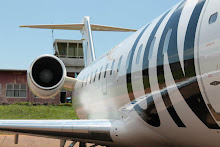This morning (bright and early at 5 a.m.) was our initial sim evaluation. It's pass/fail and marks the end of the Launch Program. My partner has less experience with RJ systems so our instructor spent a good deal of time showing him synoptics pages on the EICAS (Engine Information and Crew Alerting System). The EICAS pages have a great deal of information about the CRJ which is a very video intensive aircraft.
After the systems refresher, it was my turn to fly. I did some low RVR (Runway Visual Range) takeoffs, some hand flown and coupled departure procedures, course intercepts, direct-to intersections and other flight plan amendments. Then the instructor vectored me for some CAT II ILS approaches, both hand flown and coupled with the auto pilot. Since we were ahead of the Launch curve, we had a little extra time to fly a few missed approaches too.
As mentioned earlier, Launch is designed to be an introduction to the CRJ for the uninitiated. There's nothing difficult like V1 cuts, rejected takeoffs, rejected and balked landings or emergencies. Very straight forward with no surprises.
My partner and I both passed launch and can check off the first phase of Part 121 training at our airline. Passing the first milestone feels great.
 Picture of the cockpit with flash. The guy in the red shirt is Paul, my current sim partner. Please excuse the mess of papers covering the FMS (Flight Management System). These photos were taken just as we were switching seats.
Picture of the cockpit with flash. The guy in the red shirt is Paul, my current sim partner. Please excuse the mess of papers covering the FMS (Flight Management System). These photos were taken just as we were switching seats.
 Here's one without the flash. It's a little more representative of what the CRJ-700 sim looks like when in use.
Here's one without the flash. It's a little more representative of what the CRJ-700 sim looks like when in use.

This is the captain's seat. In a real CRJ, there is a fuse panel directly behind it. In the sim, it is on hinges and rotates out of the way to make a clear view for an observer. The seats are very comfortable and infinitely adjustable. Unfortunately, the flash washes out the view from the cockpit.
 Here's another view of the captain's seat without the flash. The level D CRJ sim is an actual cockpit delivered by Bombardier. All of the controls and displays are functional and could be installed in a line aircraft. On the top is the glareshield, which contains master warning, master caution, stall, GPWS (Ground Proximity Warning System) & flight control enunciators, engine and APU fire controls and the FCS (Flight Control System - Autopilot). The screens, from left to right, are: Primary Flight Display (Altitude Heading Reference System), Multi-Function Display (navigation, terrain and traffic data), EICAS 1 (always displays engine info, gear, flaps/slats and fuel data), EICAS 2 displays systems information (status page showing, other pages: Environmental Control Systems, Hydraulics, AC/DC Electrics, Fuel System, Flight Controls, Anti-Ice and Doors). Underneath the papers is the FMS, which controls navigation as well as landing gear, ground proximity and a few other items. Next is the throttle quadrant, which contains the thrust levers, spoilers, flaps/slats, thrust-reversers and ground spoilers. Next are the RTU's (radio tuning units), some engine system controls, EICAS controls, aileron and rudder trim, stabilizer and mach trim, radar, yaw dampers, transponders and standby RTU, display controls, cargo fire system, computer cooling fan controls, observer radio panel, parking brake, manual landing gear handle, and ADG (Air Driven Generator) controls.
Here's another view of the captain's seat without the flash. The level D CRJ sim is an actual cockpit delivered by Bombardier. All of the controls and displays are functional and could be installed in a line aircraft. On the top is the glareshield, which contains master warning, master caution, stall, GPWS (Ground Proximity Warning System) & flight control enunciators, engine and APU fire controls and the FCS (Flight Control System - Autopilot). The screens, from left to right, are: Primary Flight Display (Altitude Heading Reference System), Multi-Function Display (navigation, terrain and traffic data), EICAS 1 (always displays engine info, gear, flaps/slats and fuel data), EICAS 2 displays systems information (status page showing, other pages: Environmental Control Systems, Hydraulics, AC/DC Electrics, Fuel System, Flight Controls, Anti-Ice and Doors). Underneath the papers is the FMS, which controls navigation as well as landing gear, ground proximity and a few other items. Next is the throttle quadrant, which contains the thrust levers, spoilers, flaps/slats, thrust-reversers and ground spoilers. Next are the RTU's (radio tuning units), some engine system controls, EICAS controls, aileron and rudder trim, stabilizer and mach trim, radar, yaw dampers, transponders and standby RTU, display controls, cargo fire system, computer cooling fan controls, observer radio panel, parking brake, manual landing gear handle, and ADG (Air Driven Generator) controls.
The other important panel is the overhead. It houses controls for these systems: electrical, fire detection, lighting, fuel management, 10th & 14th stage bleed air, APU (Auxiliary Power Unit), Engines, hydraulics, pressurization, air-conditioning, and anti-ice.
There are more buttons and levers, but that's enough for today. My fingers hurt.
Now I'm off to CVG for a flight home. 4 whole days off! I can't wait to see my wife and children.






















